Dead spot between 700 rpm and 2000 rpm
- freebyrd24
-
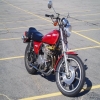 Topic Author
Topic Author
- Offline
- User
-

Registered
- Posts: 468
- Thanks: 4
Dead spot between 700 rpm and 2000 rpm
29 Jun 2015 10:37 - 29 Jun 2015 10:40
Hi everyone,
So I have recently finished putting together my 1075 build on my 1981 kz1000k1, an LTD. Not sure if this is a carb issue but I will start here. The motor is fresh, has incredible compression, valves are in spec, electronic ignition stock from the factory. New dyna 3.0 ohm coils, new plugs, new wires. I have been through the carbs dozens of times and I am sure they are clean. I have a weird problem that will NOT go away, no matter how I jet it. Richer, leaner, no change at all.
The bike will start on full choke 95% of the time. Sometimes when warm it will catch with no choke, but I usually need the choke to get it going again if it stalls. Have a 4-2 stock exhaust header with jardine slip ons. The slip ons have full baffles that are not straight through, so are fairly restrictive. I had the factory air box on with stock jets, and the problem occured. I had a dynojet kit with new components and pods that I put on just for the hell of it, and the problem is STILL there.
So when the bike starts, it shoots up to about 4-5K on full choke. I can slowly let off the choke and eventually control the bike with the throttle and no choke on. For example, I can hold the throttle around 3000 rpm and slowly bring the RPM down towards idle. While I am slowly dropping the RPM, as it hits 2,000 rpm, it falls off of a cliff and dives right to about 7-800 RPM. It will idle for maybe 10 seconds or so and then dies, plus I do not want to have it idle that low for oiling reasons. If I try to raise the idle adjustment, it will not make any difference. Seems unresponsive, until the idle is over 2000 RPM.
The bike runs and drives fantastically on the road, and is smooth throughout the RPM range (up until 5K because I am breaking in the motor), but it just doesn't idle between 700 rpm and 2000 rpm.
Not sure if I explained it that well, but I am stumped at this point. Any ideas?
I have set the fuel heights to the correct level as well. Stock BS34 Mikuni Carbs.
So I have recently finished putting together my 1075 build on my 1981 kz1000k1, an LTD. Not sure if this is a carb issue but I will start here. The motor is fresh, has incredible compression, valves are in spec, electronic ignition stock from the factory. New dyna 3.0 ohm coils, new plugs, new wires. I have been through the carbs dozens of times and I am sure they are clean. I have a weird problem that will NOT go away, no matter how I jet it. Richer, leaner, no change at all.
The bike will start on full choke 95% of the time. Sometimes when warm it will catch with no choke, but I usually need the choke to get it going again if it stalls. Have a 4-2 stock exhaust header with jardine slip ons. The slip ons have full baffles that are not straight through, so are fairly restrictive. I had the factory air box on with stock jets, and the problem occured. I had a dynojet kit with new components and pods that I put on just for the hell of it, and the problem is STILL there.
So when the bike starts, it shoots up to about 4-5K on full choke. I can slowly let off the choke and eventually control the bike with the throttle and no choke on. For example, I can hold the throttle around 3000 rpm and slowly bring the RPM down towards idle. While I am slowly dropping the RPM, as it hits 2,000 rpm, it falls off of a cliff and dives right to about 7-800 RPM. It will idle for maybe 10 seconds or so and then dies, plus I do not want to have it idle that low for oiling reasons. If I try to raise the idle adjustment, it will not make any difference. Seems unresponsive, until the idle is over 2000 RPM.
The bike runs and drives fantastically on the road, and is smooth throughout the RPM range (up until 5K because I am breaking in the motor), but it just doesn't idle between 700 rpm and 2000 rpm.
Not sure if I explained it that well, but I am stumped at this point. Any ideas?
I have set the fuel heights to the correct level as well. Stock BS34 Mikuni Carbs.
- 1981 KZ1000-K1 LTD - Long term project
1075cc Kit - New Wiseco Pistons
Sold:
- 1978 kz650 SR, 4-1 Vance and Hines Full Exhaust, Dyna-S Ignition, Accel Coils and Wires
1075cc Kit - New Wiseco Pistons
Sold:
- 1978 kz650 SR, 4-1 Vance and Hines Full Exhaust, Dyna-S Ignition, Accel Coils and Wires
Last edit: 29 Jun 2015 10:40 by freebyrd24. Reason: added info
Please Log in or Create an account to join the conversation.
- freebyrd24
-
 Topic Author
Topic Author
- Offline
- User
-

Registered
- Posts: 468
- Thanks: 4
Re: Dead spot between 700 rpm and 2000 rpm
30 Jun 2015 05:13
It may not even be a carb thing, but I'm not sure what category to start in. Any suggestions or ideas are much appreciated!
- 1981 KZ1000-K1 LTD - Long term project
1075cc Kit - New Wiseco Pistons
Sold:
- 1978 kz650 SR, 4-1 Vance and Hines Full Exhaust, Dyna-S Ignition, Accel Coils and Wires
1075cc Kit - New Wiseco Pistons
Sold:
- 1978 kz650 SR, 4-1 Vance and Hines Full Exhaust, Dyna-S Ignition, Accel Coils and Wires
Please Log in or Create an account to join the conversation.
- JR
-
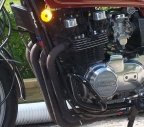
- Offline
- Sustaining Member
-

Registered
- Posts: 2960
- Thanks: 474
Re: Dead spot between 700 rpm and 2000 rpm
30 Jun 2015 05:54
My 750/4 will do something like that if the carbs are badly out of synch/balance - idle poorly below 2000 rpm and just die if idle drops to 1000. My suggestion would be to balance/synch the carbs (I use a Morgan Carbtune) and you can do this at 2000 rpm to start.
You've been through the carbs lots of time and have the correct fuel level in the float bowl so I'm guessing you may already tried this.
You've been through the carbs lots of time and have the correct fuel level in the float bowl so I'm guessing you may already tried this.
1980 kz750E1, Delkevic exhaust
Please Log in or Create an account to join the conversation.
- freebyrd24
-
 Topic Author
Topic Author
- Offline
- User
-

Registered
- Posts: 468
- Thanks: 4
Re: Dead spot between 700 rpm and 2000 rpm
30 Jun 2015 06:00
That's what I was thinking too. But I got the bike to stay at 2,000 RPM and hooked up my gauges and the readings across all 4 were nearly perfect and identical to each other. I have an older set of gauges, an old Honda factory 4 gauge set. I don't THINK it would be faulty, but I don't know how to check that. I got very consistent numbers out of the sync tool on all 4, they were typically around maybe 4" if I remember correctly.
Is there a way to see if my gauges are faulty? I checked the sync when I had the carbs off and on the bench and they looked almost perfect to the eye, then the test showed me they seemed good too.
Is there a way to see if my gauges are faulty? I checked the sync when I had the carbs off and on the bench and they looked almost perfect to the eye, then the test showed me they seemed good too.
- 1981 KZ1000-K1 LTD - Long term project
1075cc Kit - New Wiseco Pistons
Sold:
- 1978 kz650 SR, 4-1 Vance and Hines Full Exhaust, Dyna-S Ignition, Accel Coils and Wires
1075cc Kit - New Wiseco Pistons
Sold:
- 1978 kz650 SR, 4-1 Vance and Hines Full Exhaust, Dyna-S Ignition, Accel Coils and Wires
Please Log in or Create an account to join the conversation.
- Tyrell Corp
-
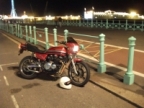
- Offline
- User
-

Registered
- "You were made as well as we could make you"
- Posts: 1650
- Thanks: 261
Re: Dead spot between 700 rpm and 2000 rpm
01 Jul 2015 05:40
Are you certain that your inlet manifold boots aren't leaking? the tiny cracks are invisible unless you squeeze them, also the flange faces sometimes don't seal. Sealant can be a temporary fix.
Has tweaking the pilot airscrews made any difference? was the pilot upjetted?
I turned my pilot airscrews out half a turn (to 2.5) and it made the whole thing a lot crisper, the sooty plugs cleaned up better within a few miles even without going anything near WOT. I think another quarter turn out maybe.
Has tweaking the pilot airscrews made any difference? was the pilot upjetted?
I turned my pilot airscrews out half a turn (to 2.5) and it made the whole thing a lot crisper, the sooty plugs cleaned up better within a few miles even without going anything near WOT. I think another quarter turn out maybe.
1980 Gpz550 D1, 1981 GPz550 D1. 1982 GPz750R1. 1983 z1000R R2. all four aces
Please Log in or Create an account to join the conversation.
- freebyrd24
-
 Topic Author
Topic Author
- Offline
- User
-

Registered
- Posts: 468
- Thanks: 4
Re: Dead spot between 700 rpm and 2000 rpm
01 Jul 2015 05:48
It does SEEM like a vacuum leak how it acts. The boots between the carbs and head are in great shape, and are pretty pliable. I can't remember if I bought these 5-6 years ago. When re-installing them, I checked the parts fiche's and saw there is no gasket or o-ring needed between the boots and the head. Is this correct?
Can or SHOULD I use some kind of sealant or RTV gasket material between the boots and the head?
Can or SHOULD I use some kind of sealant or RTV gasket material between the boots and the head?
- 1981 KZ1000-K1 LTD - Long term project
1075cc Kit - New Wiseco Pistons
Sold:
- 1978 kz650 SR, 4-1 Vance and Hines Full Exhaust, Dyna-S Ignition, Accel Coils and Wires
1075cc Kit - New Wiseco Pistons
Sold:
- 1978 kz650 SR, 4-1 Vance and Hines Full Exhaust, Dyna-S Ignition, Accel Coils and Wires
Please Log in or Create an account to join the conversation.
- A1rider
-
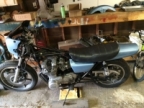
- Offline
- User
-

Registered
- Posts: 5
- Thanks: 0
Re: Dead spot between 700 rpm and 2000 rpm
01 Jul 2015 13:16
whiles its running (2000 rpm or lowest it will idle) you can spray some carb cleaner or brake cleaner around the boots and intakes and if it revs up there a Vacumm leak.
Please Log in or Create an account to join the conversation.
- missionkz
-
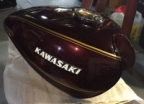
- Offline
- Sustaining Member
-

Registered
- Posts: 1622
- Thanks: 184
Re: Dead spot between 700 rpm and 2000 rpm
01 Jul 2015 16:30
Honestly just about every 900 Z1, KZ900 or KZ1000 I've ridden has mushy flattish spot off idle up to about 2000... then better to about 3000 and then starts pulling like a freight train from 3500 to 8500....
Bruce
1977 KZ1000A1
2016 Triumph T120 Bonneville
Far North East Metro Denver Colorado
1977 KZ1000A1
2016 Triumph T120 Bonneville
Far North East Metro Denver Colorado
Please Log in or Create an account to join the conversation.
- 650ed
-
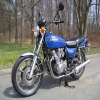
- Offline
- User
-

Registered
- Posts: 15339
- Thanks: 2833
Re: Dead spot between 700 rpm and 2000 rpm
01 Jul 2015 18:22freebyrd24 wrote: It does SEEM like a vacuum leak how it acts. The boots between the carbs and head are in great shape, and are pretty pliable. I can't remember if I bought these 5-6 years ago. When re-installing them, I checked the parts fiche's and saw there is no gasket or o-ring needed between the boots and the head. Is this correct?
Can or SHOULD I use some kind of sealant or RTV gasket material between the boots and the head?
No; there's no gasket or o-ring, and you do not need any sealant between the carb holders and cylinder head. Make sure the rubber vacuum caps on the carb sync ports are in good shape and you should check the carb holders for leaks.
They will eventually develop tiny cracks in the mating surfaces between the holders and the cylinder head that can cause them to leak at idle. These cracks cannot be seen with the carb holders in place. I suggest you try the following. Get the engine warmed up and temporarily set the idle as low as possible without killing the engine (lower than 900 rpm if possible). The lower the better because with the idle very low the slides are nearly shut and the vacuum inside the carb holders is at its highest. Then spray carb cleaner around the carb holders, especially where they mate with the cylinder head and where the carbs attach to them. Carb cleaner works best for this test as it doesn't leave an oily mess with WD40 or evaporate so quickly that it is not drawn into the leaks as can happen with propane or starting fluid (ether). If the engine dies or reacts to the carb cleaner, you need to replace the carb holders.
Carb holder leak related problems are noticeable at idle but generally don't have much impact when riding because the throttle is open. If you find you need to replace the carb holders soak the screws with Kroil for a couple days before attempting to remove them, and use JIS standard, NOT Phillips, screwdriver bits, and this will greatly improve the odds that you will not break or strip a carb holder fastener as so many have done. Let me know if you need info on JIS bits, I have a good link for making your own at no cost. Ed
1977 KZ650-C1 Original Owner - Stock (with additional invisible FIAMM horn)
Please Log in or Create an account to join the conversation.
- freebyrd24
-
 Topic Author
Topic Author
- Offline
- User
-

Registered
- Posts: 468
- Thanks: 4
Re: Dead spot between 700 rpm and 2000 rpm
01 Jul 2015 18:31
So about an hour ago, I finally did the test of spraying the boots, and ooooooh yeah I have an air leak. These boots seemed a lot better than they actually are. At this point, what's another $80-90 on carb boots? They looked perfect, so I procrastinated doing the spray test, but looks are deceiving. It seemed so obvious, and I should have done the test sooner. Thank you for your help! I will order some new ones and report back.
I'll take that link Ed too. I think I have seen it but I'll take it again!
I'll take that link Ed too. I think I have seen it but I'll take it again!
- 1981 KZ1000-K1 LTD - Long term project
1075cc Kit - New Wiseco Pistons
Sold:
- 1978 kz650 SR, 4-1 Vance and Hines Full Exhaust, Dyna-S Ignition, Accel Coils and Wires
1075cc Kit - New Wiseco Pistons
Sold:
- 1978 kz650 SR, 4-1 Vance and Hines Full Exhaust, Dyna-S Ignition, Accel Coils and Wires
Please Log in or Create an account to join the conversation.
- 650ed
-

- Offline
- User
-

Registered
- Posts: 15339
- Thanks: 2833
Re: Dead spot between 700 rpm and 2000 rpm
01 Jul 2015 18:51 - 01 Jul 2015 18:53
I know what you mean about them looking ok. Mine looked perfect but were leaking like mad and my bike idled like crap. When I removed them I found they had a lot of hairline cracks on the mating surfaces. I replaced them and the idle problem disappeared.
Do not even try to use Phillips screwdrivers on the Kawasaki cross head screws. Despite their appearance they are not Phillips screws. They are Japanese Industrial Standard (JIS) screws. The tips of Phillips screwdrivers are too long & pointed to allow the 4 blades of the screwdriver to properly engage the screws, so when you apply force the screw head slots will deform and look like crap. The fact is that Phillips screws were deliberately designed to have the screwdriver bit "cam out." This was done to prevent production line assembly from over-tightening, stripping, or breaking the screws. JIS screws do not have this problem. A proper fitting JIS bit can tighten a JIS screw to and beyond the torque spec without camming out. Here's the good news - you can easily modify standard Phillips screwdriver tips to fit the JIS screws.
I have ground down the tips of DeWalt #2 and DeWalt #3 Phillips to make them fit JIS screws. The large crosshead screws on the cases take modified #3 bits (or genuine #3 JIS bits). To modify the DeWalt bits you need to grind the very tip a little, then test fit, then grind a little more and test fit, etc. until the bit no longer "rocks" back and forth in the screwhead. Picture 1 below shows how a DeWalt #3 bit fits the case screws of my KZ650 after being ground properly. The #2 DeWalt bits can be modified the same way to fit smaller JIS screws. Pictures 2 and 3 below shows DeWalt #2 and #3 modified bits.
I did find a place that sells authentic JIS bits. They don't list the #3 bit, but if you contact them they can provide the #3 JIS bits even though they are not listed on the website. These folks were very easy to work with, and the authentic bits do work great. Here's their site:
www.rjrcooltools.com/shop_item_detail.cfm?subcat_ID=89
Pictures 4 & 5 below show a comparison between my home made modified bits with the authentic JIS bits.
Consider buying a can of Kroil penetrating oil and use it to soak stubborn fasteners for a couple days before trying to loosen them. Kroil can be bought online ( www.kanolabs.com ), at guns shows, and at some other venues. I can assure you from personal experience that it really does work.
PICTURE 1

PICTURE 2

PICTURE 3

PICTURE 4

PICTURE 5

Here's a diagram that shows the difference between JIS and Phillips:
Here's the Kroil product I use:
Do not even try to use Phillips screwdrivers on the Kawasaki cross head screws. Despite their appearance they are not Phillips screws. They are Japanese Industrial Standard (JIS) screws. The tips of Phillips screwdrivers are too long & pointed to allow the 4 blades of the screwdriver to properly engage the screws, so when you apply force the screw head slots will deform and look like crap. The fact is that Phillips screws were deliberately designed to have the screwdriver bit "cam out." This was done to prevent production line assembly from over-tightening, stripping, or breaking the screws. JIS screws do not have this problem. A proper fitting JIS bit can tighten a JIS screw to and beyond the torque spec without camming out. Here's the good news - you can easily modify standard Phillips screwdriver tips to fit the JIS screws.
I have ground down the tips of DeWalt #2 and DeWalt #3 Phillips to make them fit JIS screws. The large crosshead screws on the cases take modified #3 bits (or genuine #3 JIS bits). To modify the DeWalt bits you need to grind the very tip a little, then test fit, then grind a little more and test fit, etc. until the bit no longer "rocks" back and forth in the screwhead. Picture 1 below shows how a DeWalt #3 bit fits the case screws of my KZ650 after being ground properly. The #2 DeWalt bits can be modified the same way to fit smaller JIS screws. Pictures 2 and 3 below shows DeWalt #2 and #3 modified bits.
I did find a place that sells authentic JIS bits. They don't list the #3 bit, but if you contact them they can provide the #3 JIS bits even though they are not listed on the website. These folks were very easy to work with, and the authentic bits do work great. Here's their site:
www.rjrcooltools.com/shop_item_detail.cfm?subcat_ID=89
Pictures 4 & 5 below show a comparison between my home made modified bits with the authentic JIS bits.
Consider buying a can of Kroil penetrating oil and use it to soak stubborn fasteners for a couple days before trying to loosen them. Kroil can be bought online ( www.kanolabs.com ), at guns shows, and at some other venues. I can assure you from personal experience that it really does work.
PICTURE 1

PICTURE 2

PICTURE 3

PICTURE 4

PICTURE 5

Here's a diagram that shows the difference between JIS and Phillips:
Attachment JISvs.PhillipsAngles-2.jpg not found
Here's the Kroil product I use:
Attachment Kroil-2.jpg not found
1977 KZ650-C1 Original Owner - Stock (with additional invisible FIAMM horn)
Attachments:
Last edit: 01 Jul 2015 18:53 by 650ed.
Please Log in or Create an account to join the conversation.
- VTEC
-
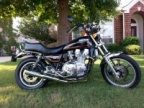
- Offline
- User
-

Registered
- Posts: 558
- Thanks: 80
Re: Dead spot between 700 rpm and 2000 rpm
09 Apr 2019 11:39missionkz wrote: Honestly just about every 900 Z1, KZ900 or KZ1000 I've ridden has mushy flattish spot off idle up to about 2000... then better to about 3000 and then starts pulling like a freight train from 3500 to 8500....
Hey Bruce. I know this is an old topic, but just wondering if this point you brought up is a background issue behind my FCR tuning problems.
With everything OEM on my worn J engine I noticed that low rpm just off-idle rough spot, but it wasn't a big deal. On the first rebuild I had almost the same issue, but worse, on basically a totally different engine with FCR35 carbs, and was able to fix it adjusting pilot air. But probably went too rich doing so.
Now another build with the same carbs and it's even worse, and cannot fix with the pilot circuit. Have to go way too rich (this time using an air/fuel meter) with pilot and needle diameter to smooth it out.
I keep wondering if these FCRS aren't compatible with my build. Like not enough vacuum off-idle to pull fuel efficiently. May have to change cam timing?
Anyway, in a few days I'm gonna bolt on the OEM carbs and compare the difference.
KZ1000-K2
ZRX1100
XR400R
ZRX1100
XR400R
Please Log in or Create an account to join the conversation.
Moderators: Street Fighter LTD
